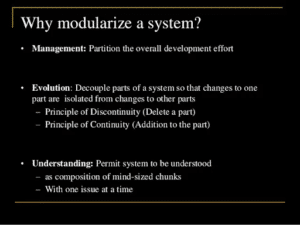Table of Contents
Modularity is defined as the degree to which a web application or software can be divided into smaller modules. Software Engineering modularity shows that the number of modules can serve a specific business domain. Using prewritten code, modularity saves resources and also provides better software development manageability.
You can modularize a design to simplify the process of planning and implementation, define and deliver software increments, smoothly accommodate changes, and conduct long-term maintenance without any serious side effects.
In the realm of software engineering, modularity extends its benefits beyond traditional development practices. It plays a pivotal role in the burgeoning landscape of Betting Apps in India, where the demand for seamless user experiences and dynamic functionalities is paramount. By adopting a modular approach, developers can craft betting platforms that offer diverse features like real-time odds updates, secure payment gateways, and personalized user interfaces. Moreover, modularity empowers these apps to swiftly adapt to evolving regulatory requirements and technological advancements, ensuring sustained relevance and competitiveness in the dynamic Indian market. Thus, the principles of modularity not only enhance software engineering practices but also underpin the success of innovative betting solutions tailored for the Indian audience.
The fundamental principle of modularity is that systems should be designed from cohesive, loosely coupled modules. This means that a system should be built using different components that work together in an efficient and effective manner.
Software engineering comes under the top 10 emerging jobs in India. To have a better understanding of modularity in software engineering and the advantages it offers, you can join the best software engineering course.
Properties of Modularity:
Modular decomposability
The ability to break down something into smaller pieces is known as decomposability. Sometimes, it is hard to solve a large problem. Modular decomposability breaks down one big problem into smaller subproblems in an organized way. It decreases the complexity and you can work on the subproblems individually.
Modular understandability
The ability to be understood or the quality of being comprehensive means understandability. Models are large and complex structures and it is difficult to understand them sometimes. Modular understandability allows you to comprehend each module by making it easier for you to design and develop software and change it according to the requirements. With the help of modular understandability, you can resolve any issue efficiently. \
Modular composability
Composability is defined as the ability to combine the created modules. It gathers the modules into a new system and handles the way two or more components are connected to each other.
Modular continuity
Continuity means uninterrupted or consistent connection for a long time. Modular continuity makes changes according to the system’s needs. These changes lead to changes in the modules too, but do not have any effect on the overall system or software.
Modular protection
In case of some abnormal activity, such as an error or failure happening in one module, modular protection defends all the other ones. The side-effects of these errors and failures are restricted within that module and the others are safe.
To learn more about the properties of modularity, you can check out these IIIT courses. They will help you develop the advanced software engineering skills you need in order to build large-scale, real-world data science applications.
Advantages of modularity

- Smaller components are easier to maintain.
- Programs can be divided on the basis of functional aspects.
- The desired level of abstraction can be introduced to the program.
- Concurrent execution can be made possible.
- Components with high usage can be reused.
Businesses face problems regarding complexity, demand, and size on a daily basis. Increased software capability requirements have forced developers to improve systems with new and better functionalities. Software engineering modularity allows you to divide applications into smaller components. Modules are divided on the basis of functionality. New functionalities are easily programmed in separate modules.
FAQs
Q1: What is the most common example of modularity?
Ans: Modules can be easily removed or replaced without affecting other components. The most common example of modularity is desktop computers because they have easily upgradeable and removable parts.
Q2: Why is modularity important in software engineering?
Ans: Modularity helps in minimizing the complexity of software or problems, making them easier to resolve.
Q3: How do you achieve modularity in software?
Ans: Effective modularity can be achieved if the separated modules are individually solvable, compilable, and modifiable.
Read more on KulFiy
